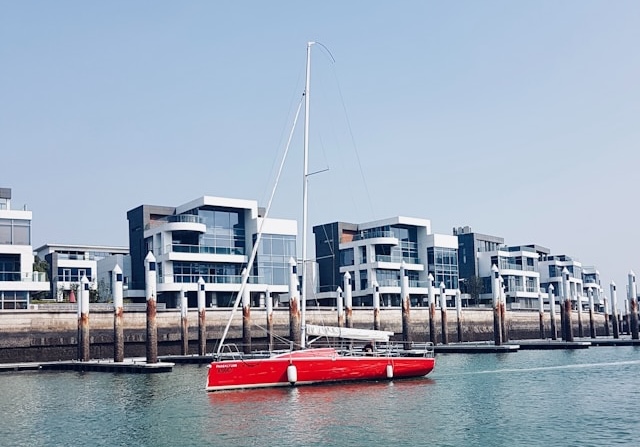Why Gulf Coast Waterfront Property Is Still One of Florida’s Smartest Investments
You’ll find Gulf Coast waterfront property a smart investment because its limited supply and rising buyer demand drive steady appreciation and strong rental income. These properties offer diverse options—from beachfront homes to canal-front residences—supported by growth in infrastructure and tourism. Plus, advantages like tax incentives and quality local services add value. While considering flood risks, tools like comparative market analyses help you make informed decisions. Exploring these factors reveals why this market remains a top choice for long-term growth.

Introduction
When you evaluate real estate opportunities in Florida, Gulf Coast waterfront properties stand out for their unique combination of lifestyle appeal and financial potential. You’ll find that limited availability, strong buyer demand, and infrastructural development drive consistent appreciation in this niche market.
Cities like Naples, Cape Coral, and Fort Myers showcase diverse gulf coast waterfront property options—from beachfront homes to canal-front residences. As a Florida real estate investment, these properties offer both long-term value growth and attractive rental income potential.
While you must factor in challenges like flood risk and regulatory considerations, data shows tax advantages and steady market performance outweigh these concerns. Making informed decisions with precise market insights maximizes your ability to serve clients seeking secure and rewarding real estate investments.
Gulf Coast investment appeal
Three key factors drive the Gulf Coast’s investment appeal: scarcity of waterfront properties, rising buyer demand, and ongoing infrastructure improvements. When you explore Florida Gulf Coast property, areas like Cape Coral canals and Naples waterfront homes demonstrate strong real estate appreciation.
Jones & Co. Realty leverages comparative market analysis to guide investors targeting second home investment or flood zone real estate informed by FEMA flood maps.
- Fort Myers waterfront and Estero waterfront development benefit from booming tourism Florida attracts, fueling short-term rental income potential.
- Bonita Springs real estate remains a hotspot due to high demand and infrastructure.
- Fort Myers Beach rental market delivers steady returns, appealing to snowbird property buyers.
- Lee County property offers diversified investment options with stable growth.
Benefits
Investing in Gulf Coast waterfront property offers significant benefits, including strong appreciation potential and steady rental income supported by high tourism demand and limited supply. Beyond financial gains, you provide valued homes that enhance lifestyles while fostering community growth.
These properties often feature access to quality infrastructure, boosting convenience for residents and guests alike. By choosing locations like Naples or Cape Coral, you tap into established markets with reliable property management and maintenance services, ensuring your investment stays competitive. Moreover, strategic use of tools like Comparative Market Analyses allows you to make data-backed decisions, improving asset performance.
Finally, tax incentives related to waterfront properties can optimize your returns. This approach supports not just your goals, but also sustains the local economies and environments you serve.
High demand, appreciation, rental income
Although waterfront properties face certain risks, they consistently experience high demand fueled by limited inventory and desirable locations along Florida’s Gulf Coast. You benefit from steady appreciation supported by strong buyer interest and regional economic growth.
Rental income remains robust, appealing to seasonal visitors and long-term renters alike. Consider these factors when investing:
- Scarcity of waterfront lots increases property values over time.
- Local infrastructure improvements enhance accessibility and desirability.
- Seasonal tourism drives consistent short-term rental demand.
- Tax incentives and favorable regulations support investment returns.
Top Areas
Limited waterfront inventory and strong buyer interest naturally concentrate opportunities in specific locations along Florida’s Gulf Coast. When evaluating top areas, consider factors like accessibility, local amenities, and community growth plans that influence property values.
Areas with established infrastructure and reputable schools tend to attract stable, long-term residents, enhancing your property’s appeal. Moreover, proximity to marinas, parks, and retail centers often drives higher rental demand.
Pay close attention to historical appreciation rates; neighborhoods with consistent year-over-year growth offer more reliable investment potential. Additionally, analyze zoning laws and flood zone designations to mitigate future risks. Using tools like Comparative Market Analyses can help you pinpoint promising neighborhoods.
Cape Coral, Naples, Fort Myers
Several key cities along Florida’s Gulf Coast—Cape Coral, Naples, and Fort Myers—stand out for their strong waterfront investment potential. You’ll find each city offers distinct advantages for serving residents and guests alike.
Cape Coral features over 400 miles of canals, providing affordable access to boat docks and water activities, appealing to families and retirees.
Naples commands premium beachfront properties with steady appreciation, attracting affluent buyers focused on luxury and sustainability.
Fort Myers benefits from ongoing infrastructure improvements and a growing rental market, ideal for investors targeting short-term vacation rentals.
All three cities show consistent year-over-year property value increases of 5-7%, supported by limited waterfront inventory and strong buyer demand.
Risks
While Cape Coral, Naples, and Fort Myers offer strong waterfront investment opportunities, it’s important to be aware of specific risks that can impact property value and returns. Market fluctuations influenced by economic shifts may affect demand and pricing. You should monitor interest rates closely, as rising rates might reduce buyer affordability, impacting resale potential.
Additionally, the limited inventory in prime locations can lead to competitive bidding, sometimes inflating purchase prices beyond intrinsic value. Keep in mind, evolving demographic trends may shift neighborhood desirability over time. As you serve clients or your community, thorough due diligence and leveraging tools like Comparative Market Analyses ensure informed decisions. By understanding and mitigating these risks, you can safeguard your investment’s long-term profitability while supporting others interested in Florida’s Gulf Coast waterfront properties.
Flooding, upkeep, regulations
Because waterfront properties on Florida’s Gulf Coast face unique environmental challenges, understanding flooding risks and maintenance demands is crucial for investors.

